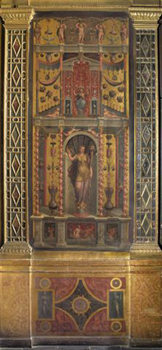Musei Civici di Arte Antica
Comune di Ferrara
The Duchesses’ Camerino
sei in: Palazzo Ducale Estense > Tour of the Estense Ducal Palace > The Ducal Palace of Estensi, now Guildhall > The Duchesses’ Camerino
salta i contenuti e vai al sommario
The Duchesses’ Camerino
 Behind the mulioned window it is possible to access the Duchesses’ changing room or small room, created for Eleonora and Lucrezia d’Este, daughters of the Duke Ercole II. This small but rich interior was decorated between 1555 and 1560 primarily by Cesare, Camillo and foremost Sebastiano Filippi (known as Bastianino).
Behind the mulioned window it is possible to access the Duchesses’ changing room or small room, created for Eleonora and Lucrezia d’Este, daughters of the Duke Ercole II. This small but rich interior was decorated between 1555 and 1560 primarily by Cesare, Camillo and foremost Sebastiano Filippi (known as Bastianino). It is one of the most fascinating interiors of the whole palace and it well represents the taste and extraordinary sophistication of the Estensi: it is a true treasure, a precious chest, pride of the city. There are several hypotheses on the original scope of this small room. Some argued that the room was employed by the Duke’s daughters who here got dressed, combed their hair, namely ‘spruced themselves up’.
It was also therefore a private and secluded room, quite common in exclusive palaces, appropriate also for secret conversations and for studying. It could also be heated quickly in the cold winter evenings precisely because of its small dimensions.
These characteristics, of an almost secret place, remained almost unaltered even when in 598 the Estensi abandoned Ferrara ceding it to the Pontifical State. So much so that the room was chosen by the Giudice dei Savi of Ferrara as his private office in the XVIII Century. Here he could study, in perfect silence, issues regarding the city administration. Indeed, if had it not been built in the XVI Century, we could say that this interior is built with modern techniques to ensure that it is perfectly sound-proof.
In the following century and until the beginning of the XX Century it was then used by the city hall secretary.
The walls of the ‘changing room’ are composed by decorative panels in painted and golden wood. They have a base characterised by geometric elements and small monochromatic figures in different poses. Upon the base are some pilasters adorned with coloured glass squares imitating precious marble. Between the pilasters are boards decorated with grotesques on golden backgrounds, with various ornamental patterns and refined allegorical and mythological figures.
We can recognise the Aboundance, who holds a cornucopia on the left (symbol of fertility and wealth, explicit reference to the opulence of the Este House) and a branch of laurel with the right hand (symbol of glory and victory), while on the opposite wall is represented Minerva.
Some of these panels recall the atmospheres of the Domus Aurea, the imperial residence built by Nero after the famous fire of 64 a.C.. Rediscovered in the Reinassance, the Domus was visited by many artists, who then employed the ornamental patterns and decorations (called ‘grotesques’) present also in the small ‘changing room’.
On the front wall, the central section contains a golden mirror divided in six parts, adorned of precious small columns and telamones, probably XVIII copies of older ones; in the middle frame, in contrast, we can observe frogs, birds, lizards and snails. Below this section, we find two more modern mirrors and a painting of modest craftmanship.
Above the window is to be noted a beautiful image of Apollo, while the two panels next to the window appear as imitations and are to be attributed to a different author of a later epoch.
Finally, on the ceiling, a painting of XVIII Century flavour portrays Aurora with the Sun Cart, another theme dear to the Estensi and that we also find in one of the halls of the Estense Castle.
Image credits:
Duchesses’ Dressing Room, The Allegory of Aboundance (detail)
photo: Conservation and Restoration Center La Venaria Reale